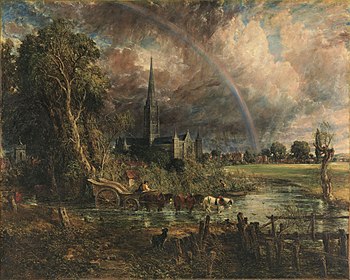| Salisbury Cathedral from the Meadows | |
|---|---|
 | |
| Artist | John Constable |
| Year | 1831 |
| Medium | Oil on canvas |
| Dimensions | 1537 mm × 970 mm (60.5 in × 38 in) |
| Location | Tate Britain, London |
Salisbury Cathedral from the Meadows was painted by John Constable in 1831, three years after the death of his wife, Maria. It is currently on display in London, at Tate Britain, in the Clore gallery. He later added nine lines from The Seasons by the eighteenth-century poet James Thomson that reveal the painting's meaning: that the rainbow is a symbol of hope after a storm that follows on the death of the young Amelia in the arms of her lover Celadon. Constable exhibited this painting at the Royal Academy in 1831, but continued working on it during 1833 and 1834. The art historians Leslie Parris and Ian Fleming-Williams have described the painting as the climax of his artistic career.
Symbolic metaphor
This painting was a personal statement of his turbulent emotions and his changing states of mind. The sky reflects this turbulence and shows his emotional state of being.
Possible political meanings have been attributed to it, one of which being the clash of industrialization and nature represented through the clash of elements.
Symbolism in this painting includes:
- Grave marker: symbol of death
- Ash tree: symbol of life
- Church: symbol of faith and resurrection
- Rainbow: symbol of renewed optimism
Constable considered this work the painting that best embodied ‘the full compass’ of his art.
Stay in the UK
In May 2013 the painting was bought by Tate for £23.1m.
The acquisition was part of Aspire, a partnership between Tate and four other national and regional galleries – National Museum Wales, the National Galleries of Scotland, Colchester and Ipswich Museums Service and Salisbury and South Wiltshire Museum – and was acquired with major grants and donations from the Heritage Lottery Fund, the Art Fund (including a contribution from the Wolfson Foundation), The Manton Foundation, and Tate Members. The partnership enabled the work to go on "almost constant" view, and ensured that it would stay in the UK.

In 2018, after a five-year tour of Britain, the painting returned to Tate Britain for permanent display. It now hangs next to JMW Turner's Caligua’s Palace and Bridge (1831). The two paintings were at the centre of a falling-out between the artists at the 1831 Royal Exhibition. Constable, that year's ‘hangman', switched the arrangement of the paintings at the last minute. Turner, unaware of the change, was infuriated by his painting's new position and "slew Constable without remorse" at a dinner they both attended, later that evening.
See also
References
- "Salisbury Cathedral from the Meadows". National Gallery, London. Archived from the original on 12 April 2012. Retrieved 27 April 2012.
- Parris, Leslie; Fleming-Williams, Ian (1991). Constable. Tate Gallery. p. 365. ISBN 1854370707.
- Constable's Salisbury Cathedral from the Meadows, Ben Pollitt, Smarthistory, accessed December 20, 2012.
- Charles 2015, p. 7
- ^ "Constable masterpiece bought by Tate for £23.1m". BBC News. 23 May 2013. Retrieved 23 May 2013.
- ^ Furness, Hannah (25 May 2018). "Tate resolves 187-year dispute as paintings by Turner and Constable hang together again". The Daily Telegraph. Archived from the original on 3 June 2023.
- Tate: Fire and Water
Bibliography
- Charles, Victoria (2015), Constable, New York: Parkstone International, ISBN 978-1-78042-954-0
External links
- Constable's England, a full text exhibition catalog from The Metropolitan Museum of Art